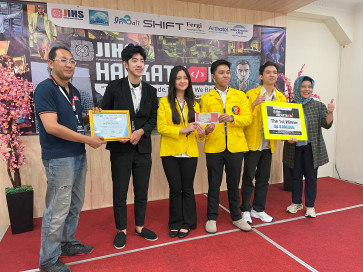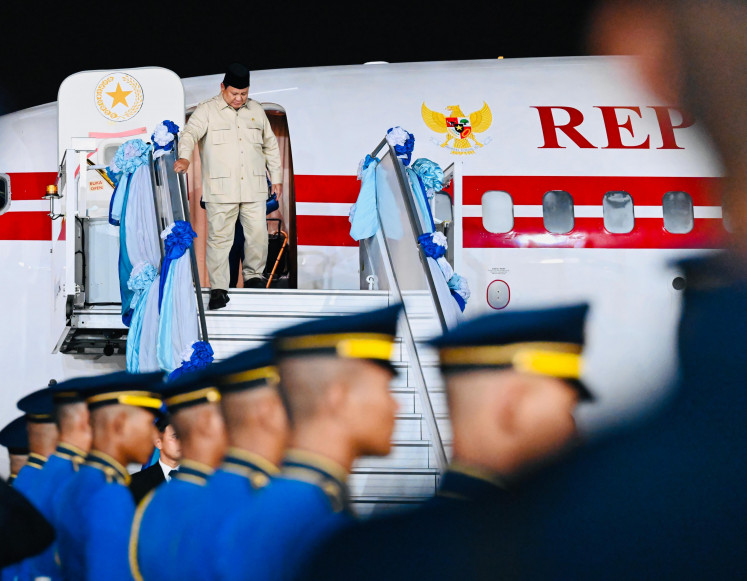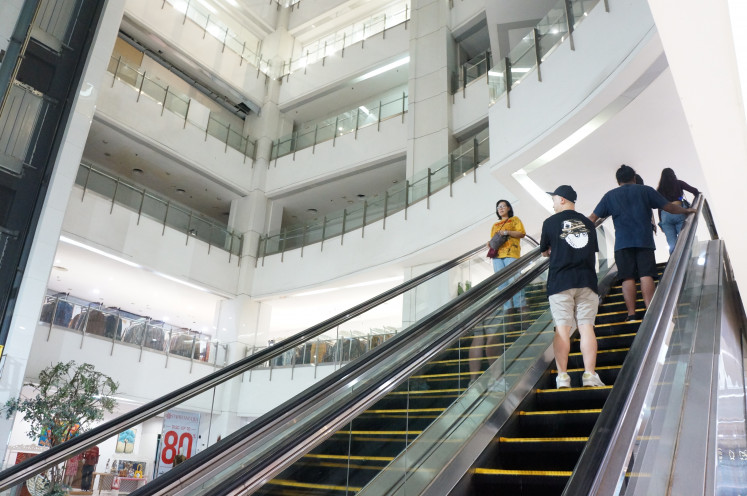Looking through the lens at Paris Photo
âSelf-Portraitâ: Archival Pigment Print by Jun Ahn, 2008, represented by Christophe Guye Galerie (Courtesy Paris Photo)At this yearâs iteration of the Paris Photo, a division was apparent between the contemporary artists, who used the international art show to sell their work, and âpureâ photographers
Change text size
Gift Premium Articles
to Anyone
 âSelf-Portraitâ: Archival Pigment Print by Jun Ahn, 2008, represented by Christophe Guye Galerie (Courtesy Paris Photo)" border="0" height="374" width="498">âSelf-Portraitâ: Archival Pigment Print by Jun Ahn, 2008, represented by Christophe Guye Galerie (Courtesy Paris Photo)
âSelf-Portraitâ: Archival Pigment Print by Jun Ahn, 2008, represented by Christophe Guye Galerie (Courtesy Paris Photo)" border="0" height="374" width="498">âSelf-Portraitâ: Archival Pigment Print by Jun Ahn, 2008, represented by Christophe Guye Galerie (Courtesy Paris Photo)At this yearâs iteration of the Paris Photo, a division was apparent between the contemporary artists, who used the international art show to sell their work, and âpureâ photographers.
Indeed, several of the artists had been displayed at the International Contemporary Art Fair (FAIC) â held in the same venue, the Grand Palais des Champs-Elysées â just two weeks previously.
While the New York gallery Zwirner, for example, showed a huge print by German Thomas Ruff at FIAC; at Paris Photo, prints tended to be smaller, more accessible and in black and white.
Paris-based Japanese photographer Aki Lumi, who has been exhibiting at Paris Photo since its inception in 1997, says the show has changed over time. âThe fine art side is being emphasized in contrast to straight photography. Paris Photo is getting increasingly commercial, which is perhaps not always favorable for the development of photography, but at the same time it means that now photography is a real big market.â
Meanwhile, one veteran German collector of contemporary art, Harald Falkenberg, said that demand for pure vintage had been losing appeal for most buyers. Others, however, disagreed, citing long-established galleries such as Howard Greenberg that booked flourishing business selling vintage prints.
There were 136 galleries represented at Paris Photo 2013, 28 of which were appearing at the show for the first time. Twenty-four nations were represented overall, including 42 French galleries, 28 American galleries and 20 German ones.
 On display: The Protest Book exhibition, curated by Martin Parr. (Marc Domage/Paris Photo)
On display: The Protest Book exhibition, curated by Martin Parr. (Marc Domage/Paris Photo)
Eric Hussenot, owner of Galerie Eric Hussenot, was back at the show this year for a second time, representing four photographers, including German painter Ebehard Havekost, who uses photography as the background for his artwork, and Martin dâOrgeval, a âpureâ photographer, who displayed abstract prints of water drops on a mirror.
Hussenotâs assistant Sonia Tricot said that the galleryâs smaller prints, priced on average at ¤1,000 (US$1,3688), were selling well to young collectors.
There was great demand at the show for photos outside the art sphere, such as photo reportage. For example, 75 historical images by famed Magnum reporter Robert Capra were sold for ¤195,000.
The owner of Galerie Lumiere des Roses, Philippe Jacquier, was already euphoric on the opening day of Paris Photo, as buyers streamed in to acquire the anonymous photography prints he had on offer, priced between ¤1,000 and ¤5,000.
These images were carefully chosen. âThese are ones which emit a certain mystery or aura,â Jacquier said.
At the higher end of the scale, Konditormeister (Pastry Cook), a vintage 1928 print by August Sander, was sold for ¤1 million to a European collector by the owner of Galerie Feroz, who also happened to be the great-grandson of the photographer.
 âUzes, 2011â: Lambda print by Georges Rousse. Photo&Contemporary, Torino. (Courtesy Paris Photo)
âUzes, 2011â: Lambda print by Georges Rousse. Photo&Contemporary, Torino. (Courtesy Paris Photo)
Organizers estimate that more than 55,000 visitors were on hand for the four-day event, despite the political street demonstrations that caused enormous traffic jams around the Grand Palais.
Ilan Engel, of Ilan Engel Gallery in Paris, was back at Paris Photo for a third time. He reported selling or exchanging all the C-prints he had on offer from 44-year-old American Stephan Crasneanacki in the first days of the fair.
Engel, who specializes in conceptual photography, said that the sales topped ¤150,000.
His mentor, fellow gallery owner Priska Pasquier, broke out from her usual vintage and contemporary offerings to present works from Rudolf Bonvie, who has been posting his images on Tumblr.
After one of Bonvieâs images from 1973 was viewed more than 80,000 times on the microblogging website, Pasquier took the plunge and offered 1,000 digital prints for ¤49 each.
Meanwhile, London and Hong Kong based gallery owner Ben Brown said that most of the images on display at his booth had been sold to French collectors. There was a Vik Muniz, classical Bechers and some Chinese prints on offer, but his Anselm Kiefer print did not sell.
âMy Hong Kong gallery is where Indonesian artists, not necessarily photographers, are favored,â Brown said. âThe next show in Asia will appeal to Asian collectors, but I am happy to have a venue at Paris Photo to increase visibility.â
 âGastropoda VIIâ: C-Print on Hahnemühle photo rag by Joan Fontcuberta. Represented by Ãngels Barcelona. (Courtesy Paris Photo)
âGastropoda VIIâ: C-Print on Hahnemühle photo rag by Joan Fontcuberta. Represented by Ãngels Barcelona. (Courtesy Paris Photo)
Indian photography was represented by Tasveer, run by Abhishek Poddar, who was content at being the first South Asian gallery on the spot, hosting masses of visitors interested in the works of a wide variety of serious Indian photographers.
Other photographers at the event took the first steps into video, such as Thierry Cohen, represented by Galerie Esther Woerdehoff. Cohen, well-known for his dark sky-line prints taken all over the world, echoed Joan Fontcubertaâs Angels video.
Multimedia, it seems, is slowly encroaching upon what has long considered to be the classical form making prints from negatives, proof that the photography world is changing.
Books, meanwhile, held their ground. Rosangela Rennoâs self-published book was named photobook of the year by the festival, while KARMA by Oscar Monzon won best first photobook.
The sheer variety of works on offer was stunning, proving that the world of photography is quite stimulating and alive.
 âPrada Girlâ: Chromogenic print by Dorothee Golz (2012). Represented by Charim Galerie Vienna. (Courtesy Paris Photo)
âPrada Girlâ: Chromogenic print by Dorothee Golz (2012). Represented by Charim Galerie Vienna. (Courtesy Paris Photo)
 âSelf-Portraitâ: <)
âSelf-Portraitâ: <)
'Self-Portrait': Archival Pigment Print by Jun Ahn, 2008, represented by Christophe Guye Galerie (Courtesy Paris Photo)
At this year's iteration of the Paris Photo, a division was apparent between the contemporary artists, who used the international art show to sell their work, and 'pure' photographers.
Indeed, several of the artists had been displayed at the International Contemporary Art Fair (FAIC) ' held in the same venue, the Grand Palais des Champs-Elysées ' just two weeks previously.
While the New York gallery Zwirner, for example, showed a huge print by German Thomas Ruff at FIAC; at Paris Photo, prints tended to be smaller, more accessible and in black and white.
Paris-based Japanese photographer Aki Lumi, who has been exhibiting at Paris Photo since its inception in 1997, says the show has changed over time. 'The fine art side is being emphasized in contrast to straight photography. Paris Photo is getting increasingly commercial, which is perhaps not always favorable for the development of photography, but at the same time it means that now photography is a real big market.'
Meanwhile, one veteran German collector of contemporary art, Harald Falkenberg, said that demand for pure vintage had been losing appeal for most buyers. Others, however, disagreed, citing long-established galleries such as Howard Greenberg that booked flourishing business selling vintage prints.
There were 136 galleries represented at Paris Photo 2013, 28 of which were appearing at the show for the first time. Twenty-four nations were represented overall, including 42 French galleries, 28 American galleries and 20 German ones.

Eric Hussenot, owner of Galerie Eric Hussenot, was back at the show this year for a second time, representing four photographers, including German painter Ebehard Havekost, who uses photography as the background for his artwork, and Martin d'Orgeval, a 'pure' photographer, who displayed abstract prints of water drops on a mirror.
Hussenot's assistant Sonia Tricot said that the gallery's smaller prints, priced on average at ¤1,000 (US$1,3688), were selling well to young collectors.
There was great demand at the show for photos outside the art sphere, such as photo reportage. For example, 75 historical images by famed Magnum reporter Robert Capra were sold for ¤195,000.
The owner of Galerie Lumiere des Roses, Philippe Jacquier, was already euphoric on the opening day of Paris Photo, as buyers streamed in to acquire the anonymous photography prints he had on offer, priced between ¤1,000 and ¤5,000.
These images were carefully chosen. 'These are ones which emit a certain mystery or aura,' Jacquier said.
At the higher end of the scale, Konditormeister (Pastry Cook), a vintage 1928 print by August Sander, was sold for ¤1 million to a European collector by the owner of Galerie Feroz, who also happened to be the great-grandson of the photographer.

Organizers estimate that more than 55,000 visitors were on hand for the four-day event, despite the political street demonstrations that caused enormous traffic jams around the Grand Palais.
Ilan Engel, of Ilan Engel Gallery in Paris, was back at Paris Photo for a third time. He reported selling or exchanging all the C-prints he had on offer from 44-year-old American Stephan Crasneanacki in the first days of the fair.
Engel, who specializes in conceptual photography, said that the sales topped ¤150,000.
His mentor, fellow gallery owner Priska Pasquier, broke out from her usual vintage and contemporary offerings to present works from Rudolf Bonvie, who has been posting his images on Tumblr.
After one of Bonvie's images from 1973 was viewed more than 80,000 times on the microblogging website, Pasquier took the plunge and offered 1,000 digital prints for ¤49 each.
Meanwhile, London and Hong Kong based gallery owner Ben Brown said that most of the images on display at his booth had been sold to French collectors. There was a Vik Muniz, classical Bechers and some Chinese prints on offer, but his Anselm Kiefer print did not sell.
'My Hong Kong gallery is where Indonesian artists, not necessarily photographers, are favored,' Brown said. 'The next show in Asia will appeal to Asian collectors, but I am happy to have a venue at Paris Photo to increase visibility.'

Indian photography was represented by Tasveer, run by Abhishek Poddar, who was content at being the first South Asian gallery on the spot, hosting masses of visitors interested in the works of a wide variety of serious Indian photographers.
Other photographers at the event took the first steps into video, such as Thierry Cohen, represented by Galerie Esther Woerdehoff. Cohen, well-known for his dark sky-line prints taken all over the world, echoed Joan Fontcuberta's Angels video.
Multimedia, it seems, is slowly encroaching upon what has long considered to be the classical form making prints from negatives, proof that the photography world is changing.
Books, meanwhile, held their ground. Rosangela Renno's self-published book was named photobook of the year by the festival, while KARMA by Oscar Monzon won best first photobook.
The sheer variety of works on offer was stunning, proving that the world of photography is quite stimulating and alive.











